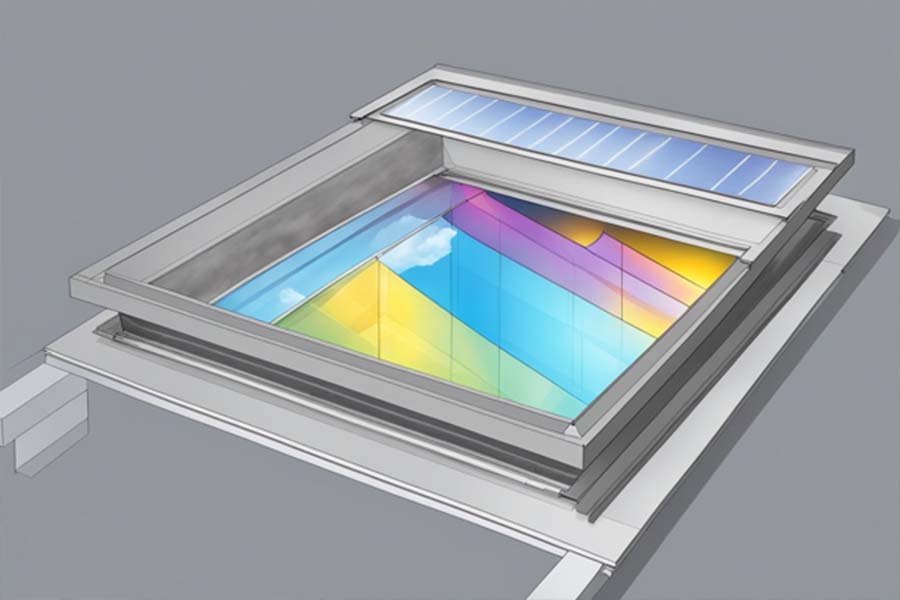Energy efficiency is a topic that has gained significant attention in recent years, as individuals and organizations alike seek to reduce their carbon footprint and save money on energy costs. One important factor in achieving energy efficiency is the role of insulation and ventilation in roof performance. Proper insulation and ventilation can significantly improve a building’s energy efficiency, while also increasing its overall comfort and durability.
Insulation plays a critical role in reducing heat loss in the winter and heat gain in the summer, helping to keep a building’s interior at a comfortable temperature while reducing the need for heating and cooling systems. Proper ventilation, on the other hand, helps to remove excess moisture and heat from a building, improving indoor air quality and preventing damage to the roof and other building materials. Both insulation and ventilation work together to create a more energy-efficient and sustainable building, while also reducing the risk of mold, mildew, and other moisture-related issues.
Understanding Energy Efficiency in Buildings
Energy efficiency in buildings is an important consideration for both homeowners and commercial property owners. Proper insulation and ventilation play a significant role in the energy efficiency of a building and can lead to significant cost savings over time.
Insulation helps to keep the interior of a building warm in the winter and cool in the summer. This is achieved by reducing heat transfer through the walls, roof, and floors. The effectiveness of insulation is measured by its R-value, which indicates the resistance to heat flow. The higher the R-value, the better the insulation.
Ventilation is also crucial for energy efficiency in buildings. Proper ventilation helps to control moisture, which can lead to mold and other issues. It also helps to regulate the temperature and air quality inside the building. There are different types of ventilation systems, including natural ventilation and mechanical ventilation.
In addition to insulation and ventilation, there are other ways to improve energy efficiency in buildings. These include using energy-efficient lighting and appliances, sealing air leaks, and using renewable energy sources such as solar panels.
Overall, understanding energy efficiency in buildings is essential for reducing energy costs and minimizing the environmental impact of buildings. Proper insulation and ventilation are key components of energy efficiency, but there are many other factors to consider as well. By taking a holistic approach and implementing energy-efficient practices, building owners can save money and reduce their carbon footprint.
Fundamentals of Insulation in Roof Performance
Insulation plays a vital role in the energy efficiency of a building’s roof. It helps to reduce heat loss during the winter and heat gain during the summer, thereby reducing the amount of energy required to maintain a comfortable indoor temperature.
One of the key factors in insulation performance is its thermal resistance, which is commonly referred to as R-value. The higher the R-value, the better the insulation’s ability to resist heat transfer. The R-value of insulation depends on its thickness, density, and the material it is made of.
Another important factor is the type of insulation used. Common types of insulation include fiberglass, cellulose, and foam. Each type has its own advantages and disadvantages, and the choice of insulation depends on factors such as cost, performance, and environmental impact.
Proper installation of insulation is also critical to its performance. Gaps, compression, and inadequate coverage can all reduce the effectiveness of insulation. Therefore, it is important to hire a professional installer who has the necessary expertise to install insulation correctly.
In summary, insulation is a key component in the energy efficiency of a building’s roof. Choosing the right type of insulation, ensuring proper installation, and achieving a high R-value can all contribute to a more energy-efficient building.
The Impact of Ventilation on Energy Efficiency
Proper ventilation plays a crucial role in maintaining energy efficiency in buildings. Inadequate ventilation can lead to a buildup of moisture, which can cause damage to the roof and insulation. This can result in higher energy bills due to the loss of insulation effectiveness.
Ventilation can help reduce the buildup of moisture by allowing air to circulate through the roof space. This can help prevent the growth of mold and mildew, which can cause health problems. Additionally, proper ventilation can help regulate the temperature in the roof space, which can help reduce the load on the cooling system during hot weather.
There are several types of ventilation systems that can be used to maintain energy efficiency. These include ridge vents, soffit vents, and gable vents. Ridge vents are installed along the length of the roof ridge, while soffit vents are installed under the eaves. Gable vents are installed in the gable ends of the roof.
Proper installation and maintenance of these ventilation systems is important to ensure their effectiveness. It is recommended that a professional contractor be consulted to determine the best ventilation system for a particular building and to ensure proper installation.
In conclusion, ventilation is a critical component of energy efficiency in buildings. Proper ventilation can help reduce moisture buildup, regulate temperature, and reduce energy bills. It is important to consult with a professional contractor to determine the best ventilation system for a particular building.
Types of Insulation Materials and Their Properties
Insulation is a crucial component in the construction of energy-efficient roofs. It helps to reduce heat transfer, which in turn reduces energy consumption and costs. There are several types of insulation materials available, each with its own unique properties.
Fiberglass Insulation
Fiberglass insulation is the most commonly used type of insulation material. It is made of tiny glass fibers that are spun into a wool-like material. Fiberglass insulation is available in batts, rolls, and loose-fill forms. It is easy to install and has a relatively low cost.
Cellulose Insulation
Cellulose insulation is made from recycled paper products, such as newspapers and cardboard. It is treated with fire retardants to make it resistant to combustion. Cellulose insulation is available in loose-fill and blown-in forms. It has a higher insulation value than fiberglass and is more environmentally friendly.
Spray Foam Insulation
Spray foam insulation is a two-part liquid that is sprayed onto the roof surface. It expands and hardens, creating a continuous layer of insulation. Spray foam insulation has a high insulation value and is ideal for irregularly shaped roofs. It is also an effective air barrier, reducing air leakage and improving energy efficiency.
Reflective Insulation
Reflective insulation is made of a thin layer of aluminum foil that is laminated to a layer of plastic or paper. It reflects radiant heat and is often used in hot climates. Reflective insulation is available in rolls and sheets and can be installed over existing insulation.
In conclusion, choosing the right insulation material is an important decision when it comes to energy-efficient roof construction. Each type of insulation material has its own unique properties and benefits. By selecting the appropriate insulation material for the specific roof, homeowners and property owners can improve energy efficiency and reduce costs.
Ventilation Strategies for Optimal Roof Performance
Proper ventilation is crucial to ensure optimal roof performance and energy efficiency. Ventilation helps to regulate temperature and moisture levels, preventing the buildup of heat and moisture that can lead to damage and energy loss.
There are several ventilation strategies that can be employed to achieve optimal roof performance. One effective strategy is to use ridge vents, which are installed at the peak of the roof and allow hot air to escape. This helps to prevent the buildup of heat and moisture in the attic, which can lead to damage and energy loss.
Another effective ventilation strategy is to use soffit vents, which are installed along the eaves of the roof and allow cool air to enter the attic. This helps to regulate temperature and moisture levels, preventing the buildup of heat and moisture that can lead to damage and energy loss.
In addition to ridge and soffit vents, other ventilation strategies can be employed, such as gable vents and roof vents. It is important to consult with a professional to determine the best ventilation strategy for your specific roof and climate conditions.
Proper ventilation not only helps to ensure optimal roof performance and energy efficiency, but it also helps to extend the life of the roof and prevent costly repairs. By implementing effective ventilation strategies, homeowners can enjoy a more comfortable and energy-efficient home while also protecting their investment.
Insulation Techniques for Enhanced Energy Conservation
Insulation plays a crucial role in enhancing energy efficiency and reducing energy consumption in buildings. Proper insulation helps to maintain a comfortable indoor temperature while reducing the need for heating and cooling systems. In this section, we will discuss some of the most effective insulation techniques for enhanced energy conservation.
1. Spray Foam Insulation
Spray foam insulation is a popular technique for insulating roofs and walls. It involves spraying a liquid foam insulation material onto the surface, which then expands and hardens to create an airtight seal. This technique is highly effective in reducing air leakage and improving energy efficiency, as it seals all gaps and cracks that may let air in or out.
2. Fiberglass Insulation
Fiberglass insulation is another popular technique for insulating roofs and walls. It involves installing batts or rolls of fiberglass insulation between the framing studs. This technique is highly effective in reducing heat transfer and improving energy efficiency, as it traps air within the fibers, which acts as an insulating material.
3. Cellulose Insulation
Cellulose insulation is a cost-effective and eco-friendly insulation technique that involves blowing in recycled paper or cardboard fibers into the attic or wall cavities. This technique is highly effective in reducing air leakage and improving energy efficiency, as it fills all gaps and cracks and creates an airtight seal.
4. Radiant Barrier Insulation
Radiant barrier insulation is a specialized technique that involves installing a reflective material on the underside of the roof. This technique is highly effective in reducing heat transfer and improving energy efficiency, as it reflects radiant heat away from the roof and back into the atmosphere.
In conclusion, proper insulation is essential for enhancing energy efficiency and reducing energy consumption in buildings. By using the above insulation techniques, building owners can significantly reduce their energy bills while creating a comfortable and sustainable indoor environment.
Roof Design Considerations for Insulation and Ventilation
When it comes to designing a roof for energy efficiency, insulation and ventilation are two key factors that must be considered. Proper insulation and ventilation can significantly improve a roof’s performance, while also reducing energy costs and increasing comfort levels inside the building.
Insulation is important because it helps to prevent heat loss in the winter and heat gain in the summer. When designing a roof for insulation, it is important to consider the R-value, which is a measure of the insulation’s resistance to heat flow. The higher the R-value, the better the insulation.
Ventilation is important because it helps to remove moisture and heat from the attic space, which can cause damage to the roof and reduce its lifespan. When designing a roof for ventilation, it is important to consider the type and location of vents, as well as the size of the attic space.
There are several design considerations that must be taken into account when designing a roof for insulation and ventilation. These include:
- Roof slope: The slope of the roof can impact the amount of insulation that is required, as well as the type of ventilation that is needed.
- Roofing material: The type of roofing material can impact the amount of insulation that is required, as well as the type of ventilation that is needed.
- Attic space: The size and shape of the attic space can impact the type and location of vents that are needed.
- Climate: The climate in which the building is located can impact the amount of insulation that is required, as well as the type of ventilation that is needed.
By taking these design considerations into account, architects and builders can design roofs that are both energy-efficient and durable. This can lead to significant cost savings over the life of the building, while also improving comfort levels for occupants.
Building Codes and Standards for Energy Efficiency
Building codes and standards play a crucial role in ensuring that buildings are constructed and operated in an energy-efficient manner. They provide guidelines and requirements for the design, construction, and operation of buildings, including their insulation and ventilation systems.
In the United States, building codes and standards related to energy efficiency are established by the International Code Council (ICC) and the American Society of Heating, Refrigerating and Air-Conditioning Engineers (ASHRAE). These codes and standards are regularly updated to reflect advancements in building science and technology, as well as changes in energy policies and regulations.
One of the most widely recognized building codes related to energy efficiency is the International Energy Conservation Code (IECC). The IECC sets minimum requirements for the energy efficiency of buildings, including their insulation and ventilation systems. It also provides guidance on the use of renewable energy sources, such as solar panels and wind turbines.
Another important standard related to energy efficiency is ASHRAE Standard 90.1, which provides minimum requirements for the energy efficiency of commercial buildings. This standard covers a wide range of building systems, including heating, ventilation, and air conditioning (HVAC) systems, lighting, and building envelope components such as insulation and windows.
In addition to these codes and standards, there are also voluntary certification programs, such as LEED (Leadership in Energy and Environmental Design), that provide recognition for buildings that meet high standards of energy efficiency and sustainability. These programs often require buildings to exceed the minimum requirements set by building codes and standards.
Overall, building codes and standards are essential for ensuring that buildings are constructed and operated in an energy-efficient manner. They provide a framework for designing and constructing buildings that are not only energy-efficient, but also comfortable, safe, and healthy for their occupants.
The Role of Weather and Climate in Insulation Effectiveness
Effective insulation is a crucial component of energy-efficient roofs. However, the effectiveness of insulation can be influenced by various weather and climate factors. In this section, we will discuss the impact of weather and climate on insulation effectiveness.
Temperature
Temperature is a significant factor affecting the performance of insulation. In cold climates, the insulation should be thick enough to prevent heat loss, and in warmer climates, insulation should be installed to prevent heat gain. Additionally, the temperature difference between the inside and outside of a building can affect the insulation’s performance. The greater the temperature difference, the more important it is to have effective insulation.
Humidity
Humidity can also impact insulation effectiveness. High humidity levels can reduce the insulation’s ability to resist heat transfer. In humid climates, insulation should be installed with a vapor barrier to prevent moisture from entering and damaging the insulation.
Wind
Wind can also affect insulation effectiveness. In windy areas, insulation may shift and settle, leaving gaps that can reduce its effectiveness. Proper installation and fastening of insulation can help prevent this.
Precipitation
Precipitation can also have an impact on insulation effectiveness. Wet or damp insulation can lose some of its insulating properties, and water damage can render insulation ineffective. Proper drainage and ventilation can help prevent moisture buildup and protect insulation from water damage.
In conclusion, weather and climate play a significant role in the effectiveness of insulation. Proper installation, thickness, and maintenance of insulation can help ensure that it performs optimally, regardless of the weather and climate conditions.
Advancements in Insulation and Ventilation Technologies
Insulation and ventilation technologies have come a long way in recent years, providing homeowners and builders with more options than ever before. These advancements have led to increased energy efficiency, improved indoor air quality, and enhanced overall building performance.
One major advancement in insulation technology is the development of spray foam insulation. This type of insulation provides a seamless air barrier, reducing air leakage and improving energy efficiency. It also has a higher R-value per inch than traditional insulation, allowing for greater thermal resistance in a smaller space.
Another innovation in insulation is the use of aerogel insulation. This material is composed of 90% air, making it an extremely lightweight and effective insulator. It has a very low thermal conductivity, making it ideal for use in areas with limited space, such as walls and roofs.
In terms of ventilation, the use of smart ventilation systems is becoming more common. These systems use sensors to monitor indoor air quality and adjust ventilation rates accordingly. This not only improves indoor air quality but also helps to reduce energy consumption by only ventilating when necessary.
Additionally, the use of heat recovery ventilation systems has become more prevalent. These systems recover heat from outgoing air and use it to preheat incoming fresh air, reducing the amount of energy needed to heat or cool the air.
Overall, these advancements in insulation and ventilation technologies have provided builders and homeowners with more options to improve energy efficiency and building performance. As technology continues to evolve, it is likely that even more innovative solutions will emerge.
Economic Benefits of Efficient Roof Insulation and Ventilation
Efficient roof insulation and ventilation provide significant economic benefits for building owners and occupants. Here are some of the ways in which energy-efficient roofs can help save money:
Lower Energy Bills
A well-insulated and ventilated roof reduces the amount of energy needed to heat and cool a building. This translates into lower energy bills for building owners and tenants. According to the U.S. Department of Energy, heating and cooling account for 48% of the energy use in the average American home. By improving roof insulation and ventilation, building owners can save up to 30% on their energy bills.
Longer Roof Lifespan
Efficient roof insulation and ventilation can also help extend the lifespan of a roof. By reducing the temperature fluctuations that cause thermal stress, a well-insulated and ventilated roof experiences less wear and tear over time. This means that building owners can avoid costly roof repairs and replacements, which can save thousands of dollars in the long run.
Increased Property Value
Energy-efficient roofs can also increase the value of a property. According to a study by the Lawrence Berkeley National Laboratory, homes with energy-efficient features sell for an average of 9% more than similar homes without these features. This means that building owners who invest in efficient roof insulation and ventilation can expect to see a return on their investment when it comes time to sell their property.
In summary, efficient roof insulation and ventilation provide significant economic benefits for building owners and occupants. By reducing energy bills, extending the lifespan of the roof, and increasing property value, energy-efficient roofs are a smart investment for any building owner.
Environmental Impact of Enhanced Roof Insulation
Enhancing roof insulation can have a significant positive impact on the environment. By reducing the amount of energy required to heat and cool a building, enhanced roof insulation can help to reduce greenhouse gas emissions and combat climate change.
According to the U.S. Department of Energy, heating and cooling account for approximately 48% of the energy use in a typical U.S. home. By properly insulating and ventilating the roof, homeowners can reduce the amount of energy needed to maintain a comfortable indoor temperature, resulting in lower energy bills and a reduced carbon footprint.
In addition to reducing energy consumption, enhanced roof insulation can also help to reduce the amount of waste generated during construction and demolition. By extending the lifespan of a building and reducing the need for repairs and replacements, enhanced roof insulation can help to conserve natural resources and reduce the amount of waste sent to landfills.
Overall, enhancing roof insulation is a simple and effective way to improve the energy efficiency of a building and reduce its environmental impact. By investing in enhanced roof insulation, homeowners can save money on energy bills, reduce their carbon footprint, and contribute to a more sustainable future.
Case Studies: Successful Insulation and Ventilation Systems
Insulation and ventilation are critical components of a roof’s performance, and there are many successful case studies that demonstrate their importance. Here are a few examples:
Case Study 1: Commercial Building in Chicago
A commercial building in Chicago was experiencing high energy bills due to poor insulation and ventilation. The building owner decided to invest in a new insulation and ventilation system, and the results were impressive. The energy bills were reduced by 25%, and the indoor air quality improved significantly. The new system included a combination of spray foam insulation, which provided an airtight seal, and a ventilation system that allowed for proper air flow.
Case Study 2: Residential Home in California
A residential home in California was experiencing hot and stuffy conditions during the summer months, despite having air conditioning. The problem was traced back to poor insulation and ventilation in the attic. The homeowner invested in a new insulation and ventilation system, which included blown-in insulation and a ventilation fan. The result was a significant improvement in indoor comfort, and a reduction in energy bills.
Case Study 3: School in Texas
A school in Texas was experiencing high energy bills and poor indoor air quality. The problem was due to inadequate insulation and ventilation in the roof. The school district decided to invest in a new insulation and ventilation system, which included a combination of rigid foam insulation and a ventilation system that provided proper air flow. The result was a 30% reduction in energy bills, and a significant improvement in indoor air quality.
These case studies demonstrate the importance of insulation and ventilation in roof performance. By investing in a quality insulation and ventilation system, building owners can improve indoor comfort, reduce energy bills, and improve indoor air quality.





0 Comments